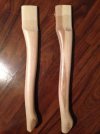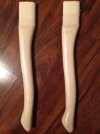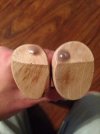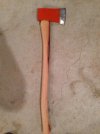This has been discussed in the past, but it is worth re-posting.
In many species (including hickory), there is no difference between the strength properties of sound sapwood and sound heartwood.
In many ring porous hardwoods (hickory, ash, oak), the wider growth rings (up to a degree) usually result in stronger wood.
In many softwoods (woods from conifers) the narrower growth rings result in stronger woods (see the table at the end of this post).
However, the value of these rules is not absolute, since there is a wide variety of growth conditions (soil, local climate etc.) which might result in similar strength properties in superficially different looking wood specimens. Proper processing (drying, storage) of the wood is also very important regarding the ultimate strength of a tool handle wood.
http://www.fpl.fs.fed.us/documnts/fplrn/fplrn147.pdf
In over 500,000 tests made by the Forest Products Laboratory on woods grown in the United States, no effect upon the mechanical properties of the wood due to its change from sapwood into heartwood has been found in most species. The heartwood of oak, pine, and Douglas-fir, for example, is not intrinsically stronger than the sapwood, as has often been supposed to be the case; nor is the sapwood of hickory and ash intrinsically stronger than the heartwood, as is sometimes claimed in connection with handle stock. However, in some species in which the heartwood is high in infiltrations or "extractives," such as redwood, western red cedar, and black locust, the heartwood has been found to be considerably stronger in certain strength properties than the sapwood. In these species, however, the amount of sapwood in virgin-growth timber is relatively small.
The following is a quote from the book of Samuel J. Record on the Mechanical Properties of Wood:
http://chestofbooks.com/home-improve...#ixzz1tTAut3Uz
"In the study of the hickories the conclusion was: "There is an unfounded prejudice against the heartwood. Specifications place white hickory, or sapwood, in a higher grade than red hickory, or heartwood, though there is no inherent difference in strength. In fact, in the case of large and old hickory trees, the sapwood nearest the bark is comparatively weak, and the best wood is in the heart, though in young trees of thrifty growth the best wood is in the sap." The results of tests from selected pieces lying side by side in the same tree, and also the average values for heartwood and sapwood in shipments of the commercial hickories without selection, show conclusively that "the transformation of sapwood into heartwood does not affect either the strength or toughness of the wood.... It is true, however, that sapwood is usually more free from latent defects than heartwood."
http://www.fpl.fs.fed.us/documnts/us...d/241hicko.pdf
"Over the years a prejudice has developed against the heartwood of hickory. Red hickory (heartwood) is often placed in a lower grade than white hickory (sapwood) simply because of its color. Tests by the Forest Products Laboratory have shown conclusively that red, white, and mixed red-and-white hickory have the same strength characteristics, regardless of color. The negative attitude toward red hickory developed during the days of virgin hickory stands. Under virgin-stand conditions the heartwood was often less dense and not as strong as the sapwood. In the second-growth stands of today this density difference does not exist, and specifications and utilization practices should be adjusted to take this fact into account.”
http://chestofbooks.com/home-improv...perties-of-Wood/Rate-Of-Growth-Continued.html
"Wide-ringed wood is often called "second-growth", because the growth of the young timber in open stands after the old trees have been removed is more rapid than in trees in the forest, and in the manufacture of articles where strength is an important consideration such "second-growth" hardwood material is preferred. This is particularly the case in the choice of hickory for handles and spokes. Here not only strength, but toughness and resilience are important. The results of a series of tests on hickory by the U.S. Forest Service show that:
"The work or shock-resisting ability is greatest in wide-ringed wood that has from 5 to 14 rings per inch (rings 1.8-5 mm thick), is fairly constant from 14 to 38 rings per inch (rings 0.7-1.8 mm thick), and decreases rapidly from 38 to 47 rings per inch (rings 0.5-0.7 mm thick). The strength at maximum load is not so great with the most rapid-growing wood; it is maximum with from 14 to 20 rings per inch (rings 1.3-1.8 mm thick), and again becomes less as the wood becomes more closely ringed. The natural deduction is that wood of first-class mechanical value shows from 5 to 20 rings per inch (rings 1.3-5 mm thick) and that slower growth yields poorer stock. Thus the inspector or buyer of hickory should discriminate against timber that has more than 20 rings per inch (rings less than 1.3 mm thick). Exceptions exist, however, in the case of normal growth upon dry situations, in which the slow-growing material may be strong and tough.” “
Interestingly, many softwoods (which are not used for making striking tool handles) show an opposite trend regarding the growth rate and wood strength:
http://www.awc.org/pdf/WSDD/C1.pdf
According to the document above, many softwoods “having medium to narrow growth rings generally have higher strength properties than those having wide rings.”
http://chestofbooks.com/home-improv...perties-of-Wood/Rate-Of-Growth-Continued.html
Experiments seem to indicate that for most species there is a rate of growth (estimated by the number of growth rings per inch) which, in general, is associated with the greatest strength, especially in small specimens. For eight conifers it is as follows:
Rings per inch
Douglas fir 24
Shortleaf pine 12
Loblolly pine 6
Western larch 18
Western hemlock 14
Tamarack 20
Norway pine 18
Redwood 30
The softwoods have different micro-anatomy than hardwoods, so there is no contradiction in these opposite trends. And even within this limited number of softwoods there are exceptions to the trend (the loblolly and shortleaf pine).







